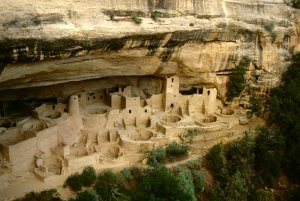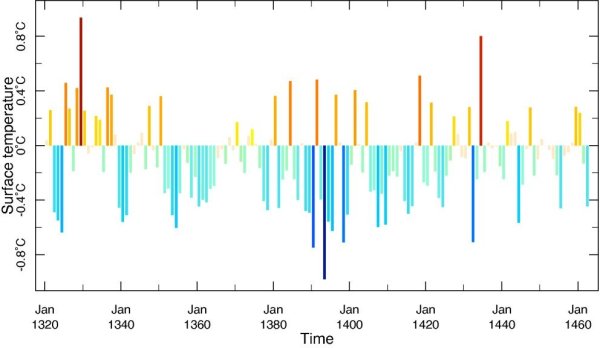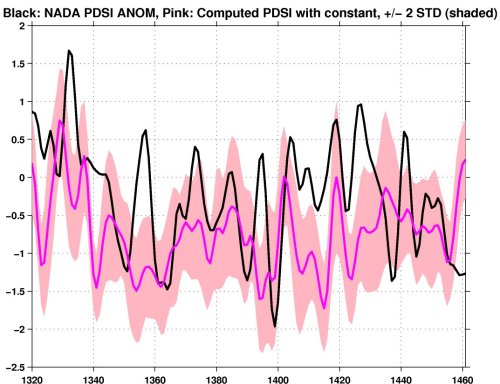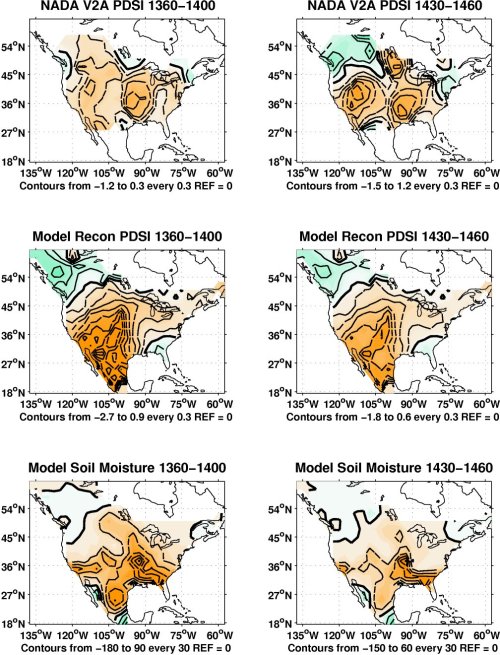 |
|
LAMONT-DOHERTY EARTH OBSERVATORY THE EARTH INSTITUTE AT COLUMBIA UNIVERSITY |
|
| Drought Research | |

|
A first attempt to model Medieval megadroughts with coral-reconstructed tropical SSTs as forcing
Tree ring records have established beyond a doubt that southwestern North America experienced a series of devastatingly severe megadroughts during the Medieval period, roughly from about 800 A.D. to the end of the fifteenth century. Some of these droughts lasted for decades at a time whereas droughts since European settlement have lasted at most a decade. Medieval droughts have been implicated as a cause of the abandonment of the Four Corners region by the ancestors of the modern Puebloan people (see Benson et al. 2007, Quaternary Science Reviews) although drought is unlikely to be the complete story. Given the pressure on water supplies in the region it is important to understand the causes of the megadroughts and determine if they could ever return. The droughts had very similar spatial patterns to modern droughts and also were part of a global Medieval hydroclimate anomaly that looks akin to those that go along with modern droughts. See Medieval megadrought. This suggests a similar cause (see "Physical causes of persistent droughts") in small variations of tropical sea surface temperatures (SSTs). There are a handful of records from fossil corals on Palmyra island that have been used to infer the SSTs when the coral grew. We have used the relationship between tropical Pacific SSTs and the oxygen isotope ratio in living corals to convert fossil coral records into SSTs. The SST averaged over the eastern and central equatorial Pacific for a continuous period from 1320 to 1462 A. D. is shown in Figure 1. The coral suggests that La Niña-like conditions prevailed during this century and a half. Elsewhere we have sought to explain this as a response to solar and volcanic radiative forcing (Emile-Geay et al., 2007). We then used the coral-reconstructed tropical Pacific SST (20S to 20N) to force a 16 member atmosphere general circulation model (GCM) ensemble over this period. The atmosphere model was coupled to a mixed layer ocean model outside of the region of SST forcing. The model simulation of North American hydroclimate was verified against the tree ring reconstructions of summer Palmer Drought Severity Index (PDSI) contained within version two of Ed Cook's North American Drought Atlas (NADA). To do that we first used SVD analysis to relate the modeled soil moisture anomaly for simulations covering the period of instrumental SST observations (1856 onward) to the tree ring PDSI for the same period. We then used that transfer function to convert the soil moisture anomaly modeled for the 1320-1462 A.D. period to a 'model-estimated' PDSI. Figure 2 shows the actual tree ring PDSI and the model-estimated PDSI, together with the two standard deviation spread within the model ensemble, averaged over the American southwest (25-40N, 125W-95W) for the entire period after six year low pass filtering. The agreement is not perfect by any means but two results are noteworthy: 1) the overall dry conditions are reproduced with about the correct amplitude and 2) much of the interannual variability of tree ring PDSI is captured by the coral SST-forced model. The overall dry conditions follow from the overall cold tropical Pacific. That any of the interannual variability matches is quite surprising given that 1) we reconstructed the SSTs from a single location, 2) the possible error on the coral dating is at least several years, and 3) coral geochemistry is not a perfect recorder of SST. Figure 3 shows the tree ring PDSI, the model-estimated PDSI and the model soil moisture anomaly (relative to the modern day period) for two megadroughts: 1360-1400 A.D. and 1430-1460 A.D. The spatial pattern and amplitude of these two extraordinarily long droughts are quite well captured. These results strongly suggest that tropical Pacific SST variations were involved in forcing the North American Medieval megadroughts. Averaged over the length of these droughts the SST anomalies were no more than a half a degree C. The dramatic impact on the landscape of the West - lower lakes, rivers run dry, see Scott Stine's article - may have come about from the persistence of the dry conditions and the lowering of water tables. But the model simulations fall far short of explaining everything. As can be seen in Figure 2, there are decadal variations in tree ring PDSI that are not captured by the model. Given that we know that tropical Atlantic SSTs can also influence drought in the West this suggests that they may have also been involved in forcing Medieval hydroclimate. This makes the recovery of high resolution proxy records of SST from the Atlantic a priority for field research. This work is described in a paper published in Journal of Climate, (Seager et al., 2007). REFERENCES
|
|
|||
LDEO home | search | ocp webmaster
Copyright © 2011 by The Trustees of Columbia University in the City of New York, Lamont-Doherty Earth Observatory.
All rights reserved.



